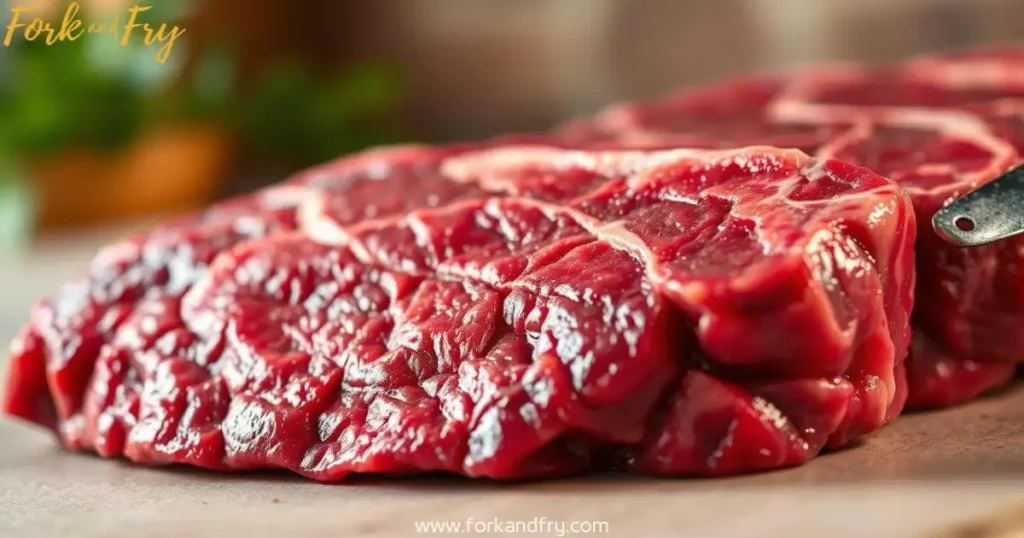Last updated on February 27th, 2025 at 07:23 pm
Table of Contents
Did you know eating bad meat can make you very sick? In the USA, bad meat from a big chain killed 7 people and hurt over 50. It’s very important to check meat before cooking. Look for signs like color, texture, and smell to make sure it’s good.
Whether you buy from a local butcher or a big store, picking quality meat is key. It makes your meal taste better and keeps you safe.

Introduction to Fresh Meat Quality
Meat freshness is vital for great taste and safety in your cooking. You can find fresh meat at butchers or supermarkets. But, knowing what to look for is essential.
In this article, we’ll cover how to spot fresh meat. We’ll talk about color, texture, smell, and packaging. These tips will help you choose the best meat for your meals.
Key Takeaways
- Check the color of the meat to ensure it’s fresh – fresh beef should be bright red, while pork should have a pinkish hue, and chicken should be light pink.
- Look for firm texture and mild odor, as slimy or sticky textures and strong smells can indicate spoilage.
- Check the packaging for excess liquid or blood, and ensure vacuum-sealed meat shows no signs of bloating.
- Choose meat from a reputable source, such as a local butcher, to ensure high-quality meat.
- Always check the sell-by date and store meat at a recommended refrigeration temperature to maintain freshness and safety.
Why Fresh Meat Quality Matters for Your Health
When you shop for meat, you want the best for your health. Fresh meat quality is key because it affects foodborne illness risks. Eating spoiled meat can cause serious health problems, like food poisoning and disease spread. Opting for organic meat, grass-fed meat, or hormone-free meat ensures quality.
Knowing about meat quality standards helps you make better choices. Look for meat that meets high standards, like grass-fed or hormone-free. This lowers illness risks and boosts nutrient intake.
When evaluating meat quality, consider these factors:
- The meat’s origin
- Production methods
- Marbling level for tenderness and flavor
- pH level for texture and water-holding
By focusing on these aspects and choosing organic meat or grass-fed meat, you ensure top-notch meat for your health.

The Color Test: Your First Visual Indicator of Fresh Meat
Choosing fresh meat is important for quality. Look at the color to check freshness. Beef should be bright red, pork pinkish, and chicken light pink.
Visiting your local butcher offers sustainable meat choices. Sustainable meat is healthier and supports green farming. Remember, color is your first clue to freshness.
Some packaging might change the color a bit. But big color changes mean the meat is old. Paying attention to meat color helps you pick quality. This trick works at local markets or supermarkets, ensuring you get fresh meat.

Understanding Meat Texture and Firmness
Choosing high-quality meat means looking at texture and firmness. You want it to feel firm but slightly springy. This is key when buying from a butcher or choosing farm-to-table options. A skilled butcher can help you pick the right cuts.
Beef should feel firm and springy, while pork is a bit softer. Marbling, or the fat in the meat, affects texture and firmness. For example, ribeye’s marbling makes it tender and tasty.

To check meat quality, use the touch test. Press your finger into it; if it springs back fast, it’s good. If it feels slimy or too soft, it’s likely spoiled. Knowing about meat texture helps you choose better and enjoy your meals more.
The Truth About Fresh Meat Odors
When it comes to fresh meat, you want it to smell right. A mild smell is normal. But if it smells sour or has a strong, foul smell, it’s best to avoid it. Organic meat and grass-fed meat should have a neutral scent, showing they are fresh and of high quality.
To check if your meat is fresh, look at the packaging and the meat itself. Check for any signs of spoilage, like a slimy texture or an off smell. If you’re buying grass-fed meat, it may have a slightly different smell. But it should be mild and not overwhelming.
Here are some tips to keep in mind when checking the smell of your fresh meat:
- Avoid meat with a strong, foul odor
- Check the packaging for any signs of spoilage
- Opt for organic meat or grass-fed meat for a more natural smell

By following these tips, you can ensure you’re getting the freshest, highest-quality meat for your meals. Remember, a mild odor is key, and fresh meat should always be your top priority.
Packaging and Label Inspection Guidelines
When you’re shopping for meat, it’s key to check the packaging and labels. This ensures you get a top-quality product. A local butcher offers hormone-free and sustainable meat options. But, it’s important to verify this by looking at the labels.
Make sure the packaging is in good shape. It should not have tears, leaks, or too much liquid. This helps keep the meat fresh and safe.
Understanding sell-by dates is also important. The sell-by date is a guide, but it’s not everything. Look for the “contains” statement and the ingredient list. These must show the percentage of added solution and list ingredients in order of how much is in them.

Temperature control is also a must. Check for any signs of temperature abuse, like thawing or freezing. By following these steps, you can be sure you’re getting a quality product. Whether you’re at a local butcher or a supermarket, always check the packaging and labels. This helps you make smart choices about the meat you buy.
Surface Moisture and Sheen: What to Look For
When picking meat, check its surface moisture and sheen. A slight sheen means it’s fresh. Too much dryness or wetness might mean it’s spoiled.
Look for a smooth, even surface on the meat. If it’s too dry or wet, it’s likely not fresh. Also, watch for iridescence, which is natural in meat. But, it doesn’t always mean the meat is spoiled.
Some important things to think about when checking moisture and sheen include:
- Muscle fibers: Meat with parallel fibers shows more iridescence when cut the right way.
- Meat cut: Meats with smooth surfaces show more iridescence than those that are rough.
- Cooking methods: Cooking at high temperatures or for a long time can make the meat lose moisture. This can make the surface less smooth and less reflective.
By looking at these factors and checking the surface moisture and sheen, you can choose better meat. This is true for butcher shops and farm-to-table markets.
Where to Source High-Quality Fresh Meat
There are several ways to get high-quality fresh meat. You can buy from a local butcher or a supermarket. Each has its own benefits. For example, a butcher might offer personalized service and organic meat choices. On the other hand, supermarkets have a wider selection and might be cheaper.
Another choice is grass-fed meat from a trusted farm or supplier. This ensures the meat is fresh, of high quality, and raised sustainably. Farms that use regenerative organic farming methods provide a special way to get quality meat.
When looking for fresh meat, consider the meat’s origin, farming practices, and the supplier’s service. You might also ask:
- What type of feed is used for the animals?
- Are the animals raised with antibiotics or hormones?
- Can I get a tour of the farm or facility?
By doing your research, you can make smart choices about where to buy your fresh meat. This way, you get the best meat for your needs and support sustainable farming.
Proper Storage Techniques for Maximum Freshness
Buying hormone-free meat from a local butcher is a great choice. To keep it fresh, you need to store it right. Make sure your fridge is at 40°F (4°C) or below. Freezers should be at 0°F (-18°C) or lower.
Raw meat can stay in the fridge for a few days. Raw pork lasts 3-5 days, and poultry 1-2 days. Freezing extends its life: beef can last 4-12 months, and ground meats 3-4 months. Always use the oldest meat first to avoid waste.
Using vacuum sealing can help meat last longer. It keeps air and bacteria out. Portioning meat into meals can also help reduce waste. Store meat on the bottom shelf to avoid contamination.
By storing meat correctly, you can enjoy it for longer. Always check the use-by date and keep meat in a sealed container. Proper storage ensures you get the most out of your hormone-free meat.
Expert Tips from Professional Butchers
Choosing high-quality meat is key. A visit to a local butcher shop can give you great insights. Butchers who focus on farm-to-table meat can help you pick the best cuts and cooking methods.
Expert butchers suggest a few things. Let the meat get to room temperature before cooking. Use a meat thermometer for even cooking. Marinate the meat for at least 30 minutes to add flavor and tenderness.
Butchers also say to rest the meat for 5-10 minutes after cooking. This makes it juicier and more flavorful.
Here are some key takeaways from professional butchers:
- Choose meat from a reputable butcher shop or farm-to-table source
- Consider the origin and quality of the meat when making your selection
- Don’t be afraid to ask your butcher for guidance on preparation and cooking methods
By following these tips and choosing high-quality meat, you can make your cooking better. Enjoy a more satisfying dining experience.
Conclusion: Mastering Fresh Meat Selection for Better Meals
Learning to pick fresh, high-quality meat is key for making tasty meals. By looking for the 9 signs of fresh meat, you can find cuts that are vibrant and full of flavor.
Whether you like tender organic grass-fed meat or lean poultry, knowing how to choose and store meat is important. This knowledge helps you make healthy and tasty choices. You’ll impress everyone with your cooking skills.
Next time you’re at the butcher or supermarket, use what you’ve learned. Become a meat expert and enjoy making meals that are delicious and good for you. Happy cooking!
FAQ
What are the key signs to look for to ensure the freshness of meat?
To check if meat is fresh, look at its color, texture, and smell. Also, check the packaging, moisture, and sheen. These signs help you know if the meat is good before you buy it.
Why is fresh meat quality important for health and food safety?
Fresh meat quality is key to avoid foodborne illnesses. Bad meat can cause serious health problems, like food poisoning. Knowing meat quality standards helps keep you and your family safe.
How can the color of meat indicate its freshness?
The color of meat tells a lot about its freshness. Beef should be bright red, pork pinkish, and chicken light pink. If it’s dull, gray, brown, or green, it’s not fresh.
What should the texture and firmness of fresh meat feel like?
Fresh meat should feel firm. Pressing it should make it spring back. If it’s slimy, sticky, or too soft, it’s spoiled.
How can the smell of meat indicate its freshness?
Fresh meat smells mild and neutral. Avoid meat with a sour, ammonia smell or a strong, foul odor. Spoiled meat can’t be made safe by cooking.
What should I look for when inspecting the packaging and labels of fresh meat?
Check if the packaging is intact and has no leaks. The sell-by date is helpful, but not everything. Look for proper packaging and temperature control too.
How can surface moisture and sheen indicate the freshness of meat?
Fresh meat has a slight sheen. Too dry or too wet means it might be spoiled. Checking moisture is key to fresh meat.
Where is the best place to source high-quality fresh meat?
Buying from a local butcher or supermarket has its pros and cons. Consider meat quality, service, and shopping experience. Ask the right questions to get the best meat.
How should I properly store fresh meat to maintain its freshness?
Store meat in a sealed container in a 40°F (4°C) fridge. Proper storage keeps meat fresh and quality high.
What expert tips can professional butchers provide for selecting fresh meat?
Butchers share valuable tips on grading and finding the best cuts. Their knowledge helps you choose the freshest meat.
Enjoyed this recipe? Leave a review!
There are no reviews yet. Be the first one to write one.






